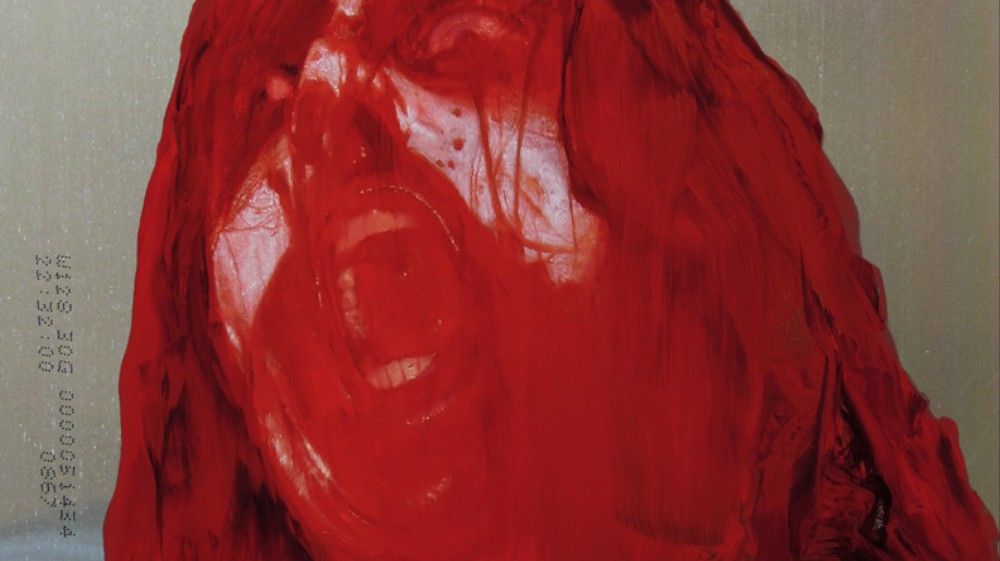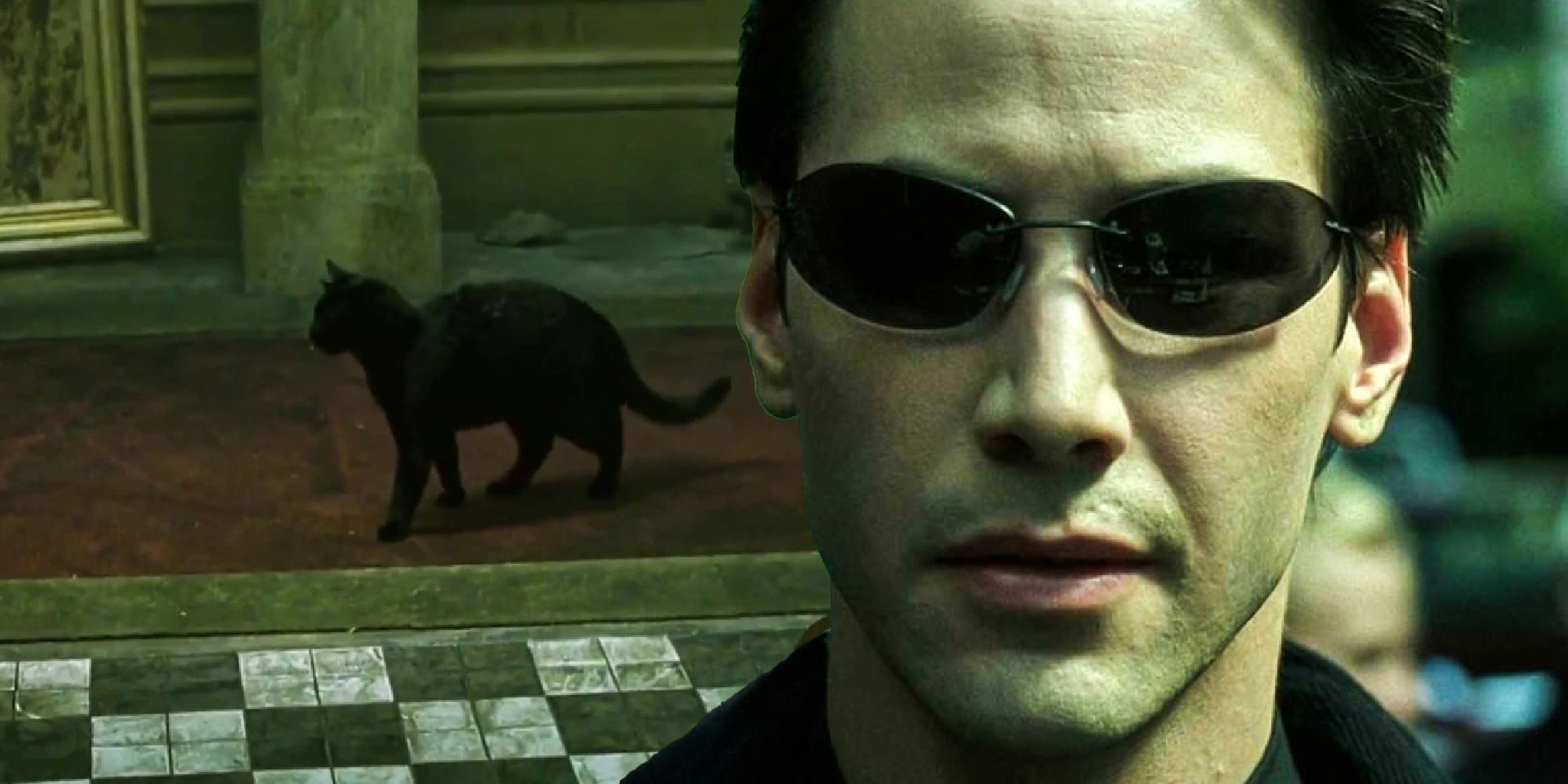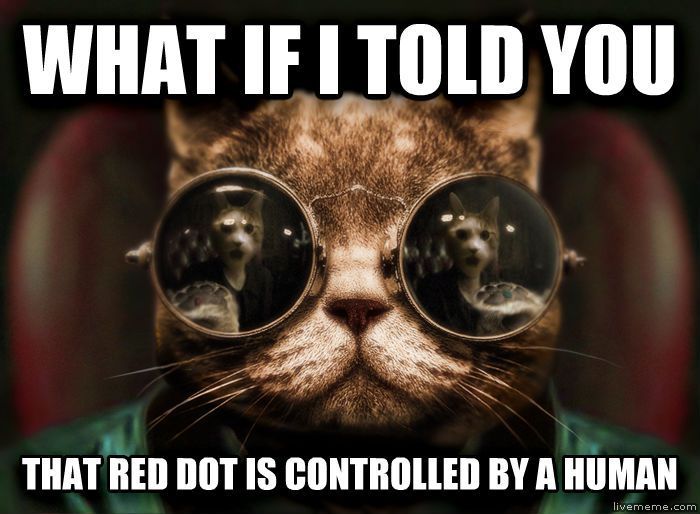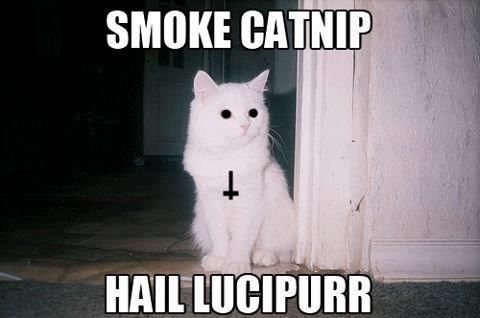Careers of Evil: Watain, the New Right, Hipsters in the Hellscape

1.
I am currently, somewhat embarrassedly, fascinated by two recent modes of stylized proselytizing that are, despite some surface differences, both alike in how they each operate. Both come out of a traditionally religious view of existential struggle. Both are (paradoxically) contrarian by design. Both may be full of shit, but not in a way that gets in a way of their respective goals.
The Satanic black metal band, Watain, has a new album, called The Agony & Ecstasy of Watain. The May issue of Vanity Fair features a piece, by James Pogue, that documents the recently held National Conservatism Conference. Watain are acolytes of Lucifer Morningstar. The attendees of the National Conservatism Conference are acolytes of Curtis Yarvin. The camps associated with either differ in how they apply their stage makeup and in which direction their crucifixes point; but what they have in common is that they both profess being privy to a hidden knowledge, and are sincere–in ways that they feel separates them from the masses–in the faith of what this hidden knowledge has revealed to them.
In the traditional tremolo-affected black metal style, an inverted mirror image of Roebuck “Pops” Staples’ use of the tremolo to add a haunted tone to the Staples Singers’ songs of Christian praise (which he called “putting some shake on it”), Watain utilizes a similarly “haunted” guitar sound to evoke a world beyond human perception, to auraly reveal visions of an end-time that’s imminent. In an update of the John Birch Society pamphleteering (best documented in James Ellroy’s Underworld USA trilogy), The New Right uses crudely drawn memes and borderline incomprehensible inter-group signifying to express, regardless its background in tech and claims to heterodoxy, a theology so rooted in centuries-old, orthodox ways of thinking that it rejects the Arthurian cuckold modernity of “might not necessarily equalling right” in favor of a Sir Mordered-masked, Morgan le Fay-funded, return to traditional virgin/whore/apostate/stake morality.
In the circles I run in, most people are proud atheists. Or they are eschatologically indifferent, but with a studied distrust for those who believe anything too fervently. Unlike many of my comrades, I don’t necessarily consider faith a character defect. Of course, part of what I love about faith is the narrative possibilities that open up when faith goes sideways. And, also of course, what makes for a good story doesn’t always make for a good life.
Watain is a rock band. Meaning that their faith might be a con. Or “show business.” The New Right uses irony in the way the English use their accents; to say banal, mean things, banking on the veneer of cleverness to get them over. Does this negate either group’s faith? Or does it make them *shake* *shudder* hipsters?
The opposite of true faith; hipsterdom. Rather, the supposed opposite of belief; hipsterdom. Without going over the term’s entire history, from jazz to Animal Collective to its current meaning of “whatever I don’t like,” hipsterdom, by my way of thinking and for the purposes of this discussion which is in my newsletter, is not the opposite of true belief. Rather, it is true belief served in the classically American buffet style. Hipsterdom implies a faith in the ephemeral and fleeting, as much as it requires an (over)capacity for ephemeral belief. Perhaps, to those inclined to shallow readings, “hipster” necessarily means a shallow fickleness. But as I said, the term, through overuse, is largely meaningless. So it means just about anything. Therefore, with no disrespect intended to the reader currently clenching their fists and swearing to their Ninja Fit that they’re not a hipster, and without discounting the trenchant observations of Search Party, it can also mean the other thing.
Watain, the Swedish theistic Satanists, led by the leather clad and elfin Erik Danielsson, play a variation of black metal that eschews the low production values prevalent to many of their peers, and leans heavily into a “blackened thrash” that makes their debt to Ride The Lightning-era Metallica as overt as the high regard, evidenced by corpse-painted faces and song titles like “From the Pulpits of Abomination,” the band holds for the genre’s church burning roots. Watain claims their commitment to the Antichrist is authentic, that their music is ritual. If the whole thing is a bit, it’s one they haven’t broken character from since the band’s formation, in 1998.
Like a lot of black metal bands, Watain are often accused of holding Nazi sympathies. Unlike a lot of black metal bands, at least ones who still paint their faces like ghouls and profess an unironic fealty to Satan, Watain also gets, well before this essay, a lot of accusations of being hipsters. A google search for “Watain hipster” gets 746,000 results. Between the two accusations, facism or fashionableness, it’s not immediately clear which one Watain takes greater offense to.
Hipster dalliance with black metal has been going on for a long(ish) time. At least since 1997’s soundtrack for Harmony Korine’s Gummo. Probably earlier, the day the first short-hair realized that there was a yet-to-be-gentrified subculture. A subculture that approximated the transgressive stance of the ultracool Baader Meinhof gang, that had an appreciation for esoteric fonts, and had the guitar sound of a hundred Johnny Marrs playing at once (with the production values of the first Pavement 7”). Certainly, throughout the aughts (and the first half of the tens), Stereogum and Pitchfork were running cutesy, fencewalking pieces on Burzum and Peste Noire; separating art from the artist like it was their job.
That said, for the first five years of the new century, most music sites (with the notable exception of Brooklyn Vegan), if they covered black metal at all, weren’t overly concerned with blackened thrash or blackened doom or black ‘n’ roll or any other slightly charred take on heavy metal that might puterifically hint at a blackened good time. Critics were only interested in black metal bands like Burzum or Wolves In the Throne Room; bands that, regardless the ugliness (or dipiness) of their intent, made sounds as pretty as any shoegaze act. Even during the infamous Heavy Metal Summer of 2005 (when bands like Battletorn, Early Man, and Valient Thorr inspired Brooklynites, disappointed in the second Interpol record and unsure if a second YYYs would ever come, to briefly switch their belts from white to bullet), head banging was seen as a novelty; an inherently silly exercise in artistic slumming, best relegated to Mondays in the basement of Lit or to be blasted semi-ironically, after closing, at American Apparel. Corpse-painted glamor boys like Immortal were still considered punchlines by the Williamsburg/Chicago intelligentsia. The grainy videos of battle-wizards running through the frostbitten woods, raising their invisible oranges to the sky, shared for larfs. So, under those circumstances, a media landscape that had yet to seriously acknowledge Ronnie James Dio-era Sabbath, it wasn’t terribly likely that a band like Watain–a band that played heavy metal in all illegible caps, limited the “atmospheric” black metal parts to less than a minute per album, and acted as though Immortal’s real problem was that Blashyrkh’s climate was too hospitable–was going to be embraced with the same fervor as bands savvy enough to know the way to a hep cat’s heart was through adding enough drone to make things “heavy,” without so much “metal” that anyone felt pressured to dance, or do anything at all.
In the establishment’s defense, Watain’s 1998 demo tape, Go Fuck Your Jewish God, was as unlistenable as a Neckbeard Deathcamp album and deservedly garnered zero attention from anyone, hipster or not. But,with the option of getting much worse largely impossible, Watain got better. Black metal purists latched on to their ensuing efforts, 2000’s Rabid Death’s Curse and 2003’s Casus Luciferi. Many of those purists will maintain that those first two albums remain Watain’s best work. Metal purists are fun. They provide a bracing context, and I’m glad that they exist. They’re also, broadly speaking, morons. The first two Watain albums are solid black metal albums, in the vein of a bunch of other black metal albums I don’t give a shit about. But Watain wouldn’t become great until they applied their ardor for cvltish esotericism and Mephistophelian grandeur to a (The) Cult-ish sense of shirtless showmanship and a Motorheadian instinct for, as Milton might have put it, rockin’ her like a doctor.

Watain’s riff mongering and earnest Luciferianism wouldn’t register with the Uniqlo crowd till they released Sworn To The Dark. Already beginning to raise the rent in that A-list neighborhood of musical snobbery; a trend that felt too alienating to become a larger trend, Decibel reading hipsters (such as myself) got onboard, furiously attempting to catch up with all the Mark McCoys, Colin Martsons, and other assorted crusty noiseniks who’d been listening to Weakling and trading illegibly fonted CDRs for years.
While increasingly popular, with Sworn to The Dark, Watain hadn’t yet crossed over to the point where anyone was questioning their trve bonafides. What criticism they did get was mainly pedants deriding them as being mere shadows of fellow Swedes, Dissection. Even their questionable politics (see: the name of their first demo, the occasional Hitler salute, the fact that their mentor in Dissection was a homophobic murderer, etc.) was largely ignored.
It’s glib to say that nobody covering metal (or other not-specifically punk genres) cared about politics until the lead-up to the Trump administration. Lots of writers did. And certainly the problematic aspects of black metal that had been inherent to it since the genre’s inception weren’t entirely glossed over. But also… yeah. Matthew Barney’s Pig Roast was very well attended by fashionable sorts (such as myself) who failed (or rather declined) to recognize any tension between grooving along to Inquisition and voting for Obama a few months later.
(Of course, considering the Obama administration’s continuation of murderous foreign policies throughout the Middle East, Africa, and South Asia, there may not have been so much tension as previously thought between supporting the future President and glossing over any heavy metal band’s sketchiness.)
To be clear, leftists have entirely fair issues with Watain. The band did wear Absurd t-shirts, have given Hitler salutes, and have maintained friendships with some of the dumbest human beings alive (Destroyer 666, MGLA, the ghost of the dude from Dissection). Not to mention the fact that Danielsson’s preference for the (very good but still) cowboy-hatted ideology-free Fields of Nephilim over the (inarguably superior) anti-colonial Sisters of Mercy can be explained only by an apolitics that trumps taste.
Over the years, Watain has repeatedly denied having any sympathy for right wing politics, with Danielsson saying “To me, it should be quite obvious that we would have been some of the first people to be executed in the Third Reich with the whole idea of the National Socialists being based upon a kingdom of bright-eyed little Aryans, and we are quite honestly the very opposite of that,” and, in later interviews, stating, “I think that when it comes to the political spectrum, which is usually what these conversations end up being about, the only thing I would ask there is for people to examine Watain a little bit and what we are saying in our lyrics and anywhere else. If they think it’s possible, try to place that on a political left and right scale, and I would be quite surprised if we ended up on the right side of that scale.”
Regardless where one falls on the question of just how fascist the authors of “The Essence of Black Purity” really are, the band’s designation, in recent years, as hipster black metal is interesting. As far as I can tell, the accusation, which started popping up with regularity around the release of 2010’s Lawless Darkness, stems largely from sites like Noisey and Pitchfork coming around to the band and the fact that Erik Danielsson dates (or dated) a clothing designer. These transgressions were seen by some as particularly glaring in the tens of the 21st Century, when the rise of decidedly unSatanic bands like Deafheaven and Liturgy cast the infernal authenticity of the entire black metal project into doubt. Still, even as black metal bands cut their hair, wiped the corpse makeup from their faces, and even occasionally sang of transcendentalism and ex-girlfriends, Watain maintained their long stringy locks, KISS-like pallor, and a po-faced dedication to Satanism. Their claims to anti-faith were buoyed by stage sets reeking of animal entrails, and quotes like this one, from Decibel Magazine: "I don’t think, I know that there is an apocalypse coming. Anyone who cannot see that is hereby encouraged to put down this magazine and take a look around them. Can’t you see the unconscious panic in your fellow man’s eyes? Can’t you smell the smoke of the fires? Can’t you hear the drums from the deep? Can’t you feel your very own body telling you ‘something is really, really wrong?’ Exercise your right to tremble with fear, man, for it is soon the only thing left to do.”
I take Watain’s claims of occultism at face value, but I do so as a choice. Part of the band’s appeal, all party rocking aside, is how adeptly they convey both the power and absurdity of faith. I have no idea whether Danielsson is completely serious or even partially kidding. But I know that if I ever find out that it’s one or the other, I’ll be disappointed with the answer either way. Conversely, my good friend, Josh Strachan (of Vaura, Azar Swan, Blacklist, etc.), sees quotes like this (and Danielsson’s quotes about the band’s politics) as “really straightforwardly winking, lefty quotes and gestures towards ambiguity in a sphere of didacticism.” He thinks “Watain is probably way more clever and less True Believer than they bring off - I think it’s an Ozzy-esque posture that’s designed as scaffolding for their smart, true philosophy of the rock star as the shaman.”
I think Josh may be right. And I don’t doubt Watain’s sincerity. Because, again, I don’t wanna. But not just because of that. And not just because they back up their claims to esoteric faith with the wearing of ritualistic animal blood, which can’t be too cozy by the third week of tour. And not just because Erik Danielsson’s interviews are maybe too consistently close to self-parody to register as jokes. And not just because Watain’s closest American cousin in end-time, existentialist mythologizing, and looping, worshipful guitar is the equally obscurantist, slyly sincere, post-hardcore theologians, Lungfish, and were some Revolution Summer scamp to replace the lyrics to any of Watain’s songs with the text of Rites of Spring’s “Drink Deep,” I doubt anyone would notice.
No sir, it is not the trappings of sincerity that tautologically convinces me of the sincerity of Watain’s beliefs. It is the opposite. Appropriately for the devil’s sidekicks, it’s through their bullshit that their (maybe) truth shines.
Like AC/DC’s “Thunderstruck,” The Agony & The Ecstasy of Watain starts with the sound of raindrop tapping on a hi hat and, like Nick Cave’s The Firstborn Is Dead, Watain’s album starts with the sound of thunder. And with that, and an album title as well suited for a Marc Almond Best Of, the band raises the curtain. The video for “We Remain,” the album’s power ballad third single, consists partially of scenes of the band doing requisite torch carrying and graveyard loitering. It also has numerous scenes of Watain’s members riding on their tour bus, chortling in backstage green rooms, sitting for fan meet-and-greets, and basically seeing a million faces and you know they rocked them all. Danielsson may claim that the song is “built around the five elemental wings of the pentagram and the mysteries embedded in that ancient symbol.” And he might further add that, “It is a song about forgotten things that ought to be remembered, the search for truths that were lost, of the ever-burning flame that illuminates the darkness of times immemorial, the passing of aeons, and our ponderable place therein.” But the video is straight up Motley Crue’s “Home Sweet Home.” Even before I’d heard the full album, Strachan wrote to tell me that it was “their best,” “such a pop record,” and “Motley Crüe 2.0.” In this, he once again had a point, even if I choose to put it to my own use.
If I refuse to agree with my friend that Watain is more sassy than Satanic, the question stands. What is Watain’s deal? What do they believe?
Well, ok. After reading endless thousand-yard stare interviews, and considering more song lyric wolf-metaphors than a Danzig in heat, let’s try to break it down.
If the misogynist/misandrist joke, about libertarianism being astrology for boys, has even a grain of truth…Watain resides next to that grain, splitting the difference like a Melinbonéian blade sliding through demonic butter. They believe in evil, as a tangible energy, that exists both within and outside the human shell. And while they espouse the doctrine of an uncaring universe, it’s a universe that “doesn’t care” in the same way a spurned ex with all your passwords doesn’t care; with omniscient malice. Even if Watain’s preferred cosmology is a particularly starless void, the band still revels in a universe that has agency and intent (Christ, the Antichrist, various representations of a bumbling God boss, and God boss’s various disgruntled and entropic former employees).
As with astrology and libertarianism, the result is conveniently solipsistic. Danielsson talks often about how his Satanism is a call to absolute freedom. But, rather than Satanism being akin to a liberation theology, everyone else’s freedom is up to them. The difference between heavy metal and punk/hardcore used to be the difference between individualism and collectivism. Corvette Firebird versus community. The shirtless half-elf barbarian versus “the kids.” Both genres are largely interchangeable nowadays (“scene” meets “scene,” and everything is community), but Watain claims no kinship with hardcore. And the band’s prescribed Satanic message is particularly bootstrap. Not that Watain would describe it so. They intend their lyrics as much a description of an objective reality as metaphor; all is chaos and destruction, with only a God of death victorious. Stellavores don’t care about striving. Try talking bootstraps to a giant nether-dimensional snake. It’s like trying to explain 3-D glasses to a cyclops.
At the end of the day, neither the notion of Watain as trickster showmen nor the idea that they genuinely believe that they are on Beelzabub’s payroll are mutually exclusive. One idle hand washes the other. The idea that worship and ritual best serves its purpose through inaccessibility and lo-fi limited tape runs was always nonsensical. While it could be argued that the Christian church required all its razzle and dazzle just to compete with Satan’s main tools for conversion (temptation being prevalent, sin being fun), it never made much sense that the devil should cede any entertainment-value ground. Rather than a beautiful church, its high stained glass windows reverberating with organ sound and melodious choir, Satan prefers his worship to be communicated by message-board insularity and Darkthrone’s soggy cardboard drum sound? For what reason? Out of Satan’s famous sense of fairness? Does the song video’s adherence to recognizable tropes most associated with hair metal homogenization and small “d” devilry undercut “We Remain”’s message of esoteric gnosis? Not a bit. Rather, like Vince Neil shouting at the devil, the medium only complexifies the message. And, in nuance, Satan usually wins.

2.
A solid case in point, in which to best illustrate the Beast with Seven Heads’ tendency to thrive in nuance, is the Vanity Fair half-apologia on behalf of a somewhat different elven, stringy haired anti-papist, a different sort of contrarian than the bad boys of Watain, but one who holds a similar appeal to those inclined to see themselves as transgressors and outlaws; Curtis Yarvin.
The New Right is a blanket term for an (ideologically at least) diverse collection of sentient saltines, broadly known as neoreactionaries, who believe that the march of progress is a pernicious lie maintained–and foisted upon decent, honest and rational people–-by the combined oppressive powers of liberalism, academia, the deep state, antifa, cancel culture, culture culture, trans activists, and everyone else who might have, at any point, worked on or enjoyed an episode of The Good Place. The neoreactionary movement, as portrayed in Vanity Fair, is largely made up of young (largely) urban professionals who profess an adherence to a nuanced principle (a willingness to debate priors, a version of science that conveniently coincides with “common sense”) they see as abandoned by the left, and an adherence to an absolute truth (God, pre-modernist masculinity) they feel the left was never in touch with in the first place. These modern day aristocrats, Medician spirits hurled forward in time to inhabit the bodies of N+1 assistant editors and various Cat Marnells stripped of charisma by sobriety, have chosen to reject the historically urbane, progressive values of cocaine use (and the time honored, though not confined to progressive circles, young urban tradition of premarital sex), in favor of collegiate, preppified loathing for democracy (at least as it stands now), and a Catholicism that hews far from any foot washin’, let love in, Jesus, and closer to the performatively grim, midievall apocalyptics of black metal.
The characters who make up the James Pogue Vanity Fair piece aren’t all yuppies or hipsters (and I use both terms as a descriptive rather than as a pejorative), but many are. Pogue describes a claque of vile bodies familiar to anyone who has spent any time at a high-end afterhours. There’s middle-tier alt fiction writers like Honor Levy (an author who, at least in the article, comes across less like a New Yorker short story writer and more like a character in a New Yorker short story, and who’s conversion to Catholicism and general insufferability makes common cause with Go Fuck Your Jewish God in making one wish Jacob had paid a bit more attention to the Covenant with God’s fine print), media provocateurs who dabble in acting/modeling like the hosts of the Red Scare podcast, a bunch of interchangeable dudes with Death in June haircuts who’s names I can’t remember (just like at every afterhours I’ve ever attended), a caustic child of an ‘80s Hollywood director (Amanda Milius, who is best known for a slick bit of Trump sycophantry and going full Conan The Destroyer on Bohos In Paradise chowderhead, David Brooks), and, of course, an ostensible liberal (Lydia Laurenson) who fucks Race Realists.
(One would think that the fate, of forever being banned from the neighborhood potluck, that fell upon Gavin McInnes’ wife, would serve as a warning about that last trope, but I suppose for some, eugenics-by-proxy, coupled with hopefully at least passable dick, is just too tempting to pass up.)
If I’m being more pointed in my criticism of the females of this coterie, it’s for a few reasons. First, the two Senate candidates described in the piece, J.D. Vance and Blake Masters, don’t fit easily into the afterhours/hipster framing. They’re both more reminiscent of the Wall Street guys who pay for drinks and cocaine all night and are crestfallen when still asked to leave the bar at 4AM. They’re both vaguely frattish, distinctly grotesque men; small-souled, mutant-hating villains in a Chris Clairmont comic that's been left too long in the rain. But both are well covered everywhere else and neither are interesting in any way unfamiliar to anyone who’s skimmed Before The Storm: Barry Goldwater and the Unmaking of the American Consensus or had an episode of Justified explained to them by a drunk child. Second, while there are men who’d fit the profile, they're largely nameless or otherwise off camera. I could try to shoehorn in some notable bro-reactionaries like Colin Wright or Bo Winegard, young-ish, overcompensating tweeters with some cachet amongst serial bible-misunderstanders and audition-porn consumers who are too shy to be racist offline. But both have built in caps to their popularity due to a certain clamminess of spirit that’s palaple through the screen of an IPhone. I don’t know that they even have the haircuts to rate an invite to NatCon.
Finally, the main villains (or anti-heroes, depending how much slack you're willing to grant James Pogue and his sometimes admirable, sometimes not, zen of reasonableness) of the piece are Curtis Yarvin and Peter Theil, two widely adored/reviled vibe shifters, both of whom, I’ll be the first to admit, are deserving of their own stand-alone, essay-length eye rolls.
Peter Thiel is a billionaire oligarch, so anti-life. and undisputedly evil, that he manages to strip both being proudly homosexual and being responsible for Gawker’s demise of their respective mitigatory qualities. Not a lot of nuance in Thiel’s worship (and misuse) of power. So he’s outside the purview of this essay. He’ll get his, in this world or the next.

As for Yarvin, well… he’s the guy who decided that the metaphor of the Matrix was too subtle, and wouldn’t it be cool to spell it out. Some people think he’s a fascist. Others, who I guess haven’t read Mark Fisher or heard Black Sabbath’s “Neon Knights,” think he’s a prophet. I don’t like the overuse of “Nazi,” but mainly because I don’t like the flattening of all the myriad of ways a person can suck. So, If you want a charitable but still insightful explainer on Yarvin, I’d suggest reading (the musician and intellectual) Charlie Looker’s thoughtful and strange essay about smoking crack and flirting with wrongthink. If you want to read Yarvin himself, I assume the “google” button on your phone is working. For myself, I did watch a few Yarvin videos. On the surface, his notion of The Cathedral seems… dumb. If not dumb then an extremely basic, conveniently-applied-to-his-personal-bugbears, rendition of the Paranoid Style, with the furniture rearranged in order to appeal to gamers and computer programmers who have had little enough human interaction to confuse the very human incompetence, laziness, and tendency towards groupthink–that I’d be the last to deny is prevalent in media and academia (as it is in every group not made up exclusively of cats or angels)--for conspiratorial malice. In Yarvin’s defense, he does posit the conspiracy as almost unintentional, with no one in charge. But culture warriors, across the political spectrum (though the right likes to pretend otherwise), long ago agreed that intentions don’t matter. And Yarvin is smart enough to know this. As with all his little thought experiments, he wants to have both influence and deniability.
Look, if people want to base their entire identities on a metaphor drawn from a Keanu Reeves movie other than Point Break, that’s certainly a choice. I suppose if my Keanu Reeves movie metaphor was taken from me, stripped of whatever useful meaning it might have ever had, and was finally and irrevocably appropriated by thousands of luckless, gormless, real-world Leisure Suit Larrys, I would probably go looking for someone to blame as well. I don’t know. I mean, like, I don’t go around calling people fascist just because they wish their lives were more like the fantasy novels they read as a kid. And I’m not going to hold Yarvin to a higher standard than I do Watain. Everybody gets to have their questionably titled demo. I’m just saying that, even before I learned that Yarvin might actually like vaporwave, I found him actively underwhelming. And I tried to read Yarvin’s blogs. But it started to feel akin to taking a dog eared copy of Cryptonomicon, carving a hole in the cover, and sticking my dick in it, American Pie style. So I went back to reading Nancy.

All and all, the Vanity Fair piece documents what would be a slow day for Thomas Morton. Or, to credit the subjects’ collective rejection of modernity; the piece is chock full of the sort of characters one would find in a Patricia Highsmith novel; the ones who would be intelligent enough to see right through Ripley, but not so savvy as to avoid their inevitable and unmourned-by-the-reader fate. Well, that analogy touches on the money, but not the insouciance. The New Right hipsters may pose that their newfound catholicism supersedes their irony derangement, but they’re not fooling themselves just for starters. So maybe their less Patricia Highsmith crime scenes than echoes of early Talking Heads lyrics, mis-taken at face value. Cruel, silly, eminently slappable.
While reactionary quasi-hipsters aren’t new (Jesse Singal loves Parquet Courts, the NRA lady has depressingly solid taste in music, Steven Miller likes Wilco or some such shit probably) those personages are hipsters more as a sideline than a calling. Their politics are essentially square, based on electoral politics and posing for pictures with cops. But for some of this New Right, especially the bloggers and podcasters who spend more waking hours waging interscene combat against each other than they do discussing policy, conservatism is the hobby. Neo-reaction is their Parquet Courts. The Catholic Church is their 285 Kent. In a few years, a lot of these people will be either dead of overdose or living comfortably in Connecticut, married to an Ezra or Emily, posting pictures from NatCon with captions that read “can you believe we were ever this young???”
I’m not being unkind because the mid-tier neo-reationaries described by James Pogue aren’t my people. I’m being unkind because, politics aside, they absolutely are. Or (politics aside) they are my people, but minutely not. And I’ve been waging war against the minutely different even before (significantly more harmless) gesture-as-meaning monarchists of an earlier hipster epoch tried to tell me that “Sex on Fire” was as good a song as “Last Nite.”
(It also doesn’t help that few of these people appear to have any discernible talent outside of performing heightened versions of themselves. Which is admirable in a way, but it’s not too terrific when Ariel Pink is the only member of your clique that anyone –at least anyone not terminally online– might give a merit-based shit about.)
Strachan disagrees with some of my interpretations. He says, “I have read a lot of that Yarvin stuff, I’ve read Land’s Dark Enlightenment start to finish which is basically exegesis and codification of Yarvin. I think they are genuine outsiders! Wrong, but true believers. As for the people who follow behind them, to me it’s all just the internet. It’s identity adornment and performance and bullshit so in that sense I totally agree (with you). I almost perceive, instead of a parallel, a linear progression. I think where black metal theatrics and ‘taking stands’ is now pretty standard run-of-the-mill, the next step, in performing one's own outsider danger to the establishment, is NRx. There are affinities, precisely because black metal was gentrified by shorthaired hipsters, it retains less of its power of outsider identification. Which ultimately brings it all back to authenticity, as the sacred highest value in contemporary counterculture, having this tendency towards murder, destruction, etc. Byung-Chul Han has written some great shit about this, it applies as much to hip hop beef shootings as to metal dudes needing to shoot people and burn things. He says, ‘Today we reject all rituals as something external, formal and therefore inauthentic. Neoliberalism produces a culture of authenticity, which places the ego at its center. The culture of authenticity develops a suspicion of ritualized forms of interaction. Only spontaneous emotions, subjective states, are authentic. Modeled behavior, for example courtesy, is written off as inauthentic or superficial. The narcissistic cult of authenticity is partly responsible for the increasing brutality of society.’ I think this, for me, is the intersection of these subcultures”
I think what Strachan says scans, and if it contradicts any of my placements of who sincerely believes what in what given category, it allows for the possibility that Yarvin and Watain are, to whatever varying degrees, sincere in their provocations, while agreeing that, boy oh boy, are many of the followers as enamored with branding as they are any belief. So, all the contradictory aspects of embodied hipsterdom are accounted for!

3.
The song “Black Cunt” (which, perhaps despite Watain’s best/worst intentions, avoids being half as offensive as the band “Black Pussy” by referencing a literally infernal, beyond-space-and-time, black hole vagina, as opposed to tedious Stonesy racism), contains the lyrics: “Irrevocable, that which awakes/Here, where the barrier breaks/A reversion of power that gives and takes/Riches to the witches, and priests/To the stakes.” Whether the last couplet is meant to evoke the specter of Bernie Sanders, or just “champagne for my real friends/real pain for my sham friends” doesn’t really matter, the effect is the same. The established order will be upended, all them witches will be rewarded with the bag, and all the pious pricks will get kicked. A reasonable person might take this moment to protest any comparisons drawn between a band of biker cosplayers practicing theistic Satanism, and an ideologically diverse gang of neo-preppies, most of whom, if not fascists exactly, would have supported the Church and Franco during the Spanish Civil War. But, then, neither black metal nor red pills are intended for “reasonable” people.
There are a number of points of convergence between my favorite sketch-adjacent black metal band and the swirling mass of New Reactionaries. Besides the most facile similarity; Watain’s hatred for Christianity and Curtis Yarvin’s use of the term, “The Cathedral,” to encompass all the (largely secular) forces he opposes, the greatest commonality between Watain and the New Right (at least the movement’s younger adherents) is of course the contrarianism. Or, as named in Watain’s cosmology: “withershin,” the movement counterclockwise, and in opposition to, the sun. For Watain (and Satanic black metal in general), the sun is God’s light. And opposing that light is part and parcel to embracing Luciferian truth. For the New Right, the sun is the (perceived) myth of Liberal progress. While most of the New Right have a real hard-on for a Christian God, they find Martin Luther King Jr.’s historical arc towards justice to be a delusional hassle.
Both black metal provocateurs and the New Right, from Yarvin on down, share the impulse to thrill at provocation, tittering as the flustered sheeple bleat, while simultaneously gnashing rows of troll teeth when “cancel culture” shows up to actually give their transgressiveness meaning. Some peers of Watain (such as Mgla, who actually use “disinformation superhighway” in a lyric, and Behemoth, whose upcoming album is about getting yelled at on Instagram) are neck-in-neck with countless Fight-For-Your-Right-To-Say-Retard-ers, who spend their days vying for an on-air tugger from Bill Maher, in the race to best make free speech ideals, that I hold extremely dear, embarrassing. If, over the years, the “left” has grown more censorious, then those, who at least partially (in absence of a uniform movement ideology) define themselves by their opposition to that censoriousness (and, coincidentaly, any other associated leftism), seem often giddy at the thought that claims to Enlightenment principles (most of which they otherwise have little use for) might lend some anti-authoritarian, Founding Father-al profundity to a dispositional inclination towards hurting stranger’s feelings on the internet and making fart jokes about Auschwitz.
With that, we return to hipsterdom; the delicious elitism that comes for all who presume to have hidden knowledge, and who then presume to base their identity upon revealed gnosis’ runes and portents. We all take undue pride in what we refuse to be suckers for. Satanic metalheads and post-left ironists alike exist within a wild and hep miasma of religiosity and hobbyism. They all worship what they despise as much as what they love, and won’t shut up about the former to the point of the latter occasionally being reduced to an afterthought. Whether it’s Christ, anti-Catholic communism, or just all those purple-haired pronoun mongers screaming at them on twitter; without the antithesis of how they get their kicks, acolytes of Watain and Theilite post-left podcasters might cease to exist. Or at least they’d cease to exist as self-regarded interesting people. Which is (clearly) the quality of both camps that I relate to most. Maybe for me, it was Pearl Jam (or The Killers or whatever) as much as it was Reaganites, Rumsfeldians, or racist jocks and skinheads with Boston accents, but I suppose we all get the barbarian at the gate we deserve, you know?
While ceding any and all other deficiencies of character, I’m still not using “hipster” as an insult. While levels of sincerity vary, to be a hipster is to be ridiculous in one’s passions. But am I trying to be dismissive of Watain and/or the New Right by linking them together with a designation that few people willingly claim? I’ve certainly, in the past, tried to hurt enemies' (and friend’s) feelings by paying them compliments that no sane person would enjoy receiving. So maybe. What I'm not doing is attempting to diminish whatever evil either concern might be complicit in.
While I was writing this essay, debating the sincerity of various artists and intellectuals who either subscribe to, or toy with, far right ideology, a white supremecist and avowed Nazi, Payton Gendron, shot thirteen Black people in a supermarket in Buffalo, NY., killing ten of them. While Gendron’s 180 page manifesto cites nobody in this essay by name, with the only musicians mentioned (and in unflattering terms) being a number of pop/rock stars of the ‘80s and ‘90s, there are obvious connections between his ideology (white replacement theory, racism, anti semitism), the means of his indoctrination (reddit, memes, the consistently repulsive Sam Hyde), and the New Right.
This is not to absolve Watain, or black metal in general, of contributing to any encouragement, large or small, of racism, antisemitism, xenophobia, or Islamophobia. While the usual partisan combattants are taking the Black Sun logo, used by both Genderson and Ukranian Nazis, to bolster their previoulsy held takes on the Ukraine, most black metal fans were probably already familiar with the signa from various t-shirts, album covers, and barely concealed tattoos. That Watain hasn’t used it yet doesn’t, in the context of all their wolves and panzerfaust font, mean much. The strongest defense of the band, besides their explicit denials of Nazi sympathy, is one they wouldn’t necessarily appreciate. Like the New Right podcasters and shit posters described in Vanity Fair, like overculture in general, the Buffalo, NY mass murderer appears to be entirely indifferent to music. The days of arguing whether metal causes fascism or rap causes gun violence, or art causes anything at all, are behind us; left mainly to hobbyists and prosecuting attorneys. That stuff is irrelevant, square even, to young people who have no need of (or patience for) calls to violence or bigotry compromised by metaphor. This is not to say that indoctrinated youth will not continue to be drawn to music that has themes which reify their already held beliefs. Just that, barring some particularly pretty child lip synching “Mourning Soul” on tik tok, music will continue its current retreat as background, a device for creating and maintaining memories, and shorthand emotional cues on television and film, with music’s external/social relevance at most being its use as cultural signifier (or red flag).
That “defense” made, let me be clear and say that, as far as I’m concerned with rationalizing anyone’s politics, all the fashionistas discussed in the essay can hang on the crosses, inverted or trad, they’ve chosen to nail themselves to over the years. If I wanted to measure totenkopf slopes, I’d have started a podcast.
(also tbc I am not suggesting that music fans should stop slapping around fash bands, online or irl, when given the opportunity, just that they should maybe be honest and admit that the beatings are negative-merit-based more than preventative.)
I don’t know what percentage of the New Right are cosplaying for a contrarian (or faux-Catholic) high, what percentage are (to use a term almost as overused as “hipster”) “grifters” mostly in it for Theilbucks or online clout, and what percentage genuinely believe that their muddle of classically conservative fear, callousness, and self-victimization is an appropriate (or remotely novel) worldview for an adult to hold in 2022. I don’t, however, have high hopes that any recent carnage might lead to any self-reflection on the part of any of those percentages. Like the broadest stereotype of the hipster, the members of the neoreactionary scene are far too adept at “I’m not like that, I’m like this”-type deflection. It is the traditionally reached for revolver of the spiritually shallow; the evasion that allows us to feel (in the immune to algorithm recesses of our hearts) heterodoxical, on the vanguard, and essentially different, even as we march in lockstep.





